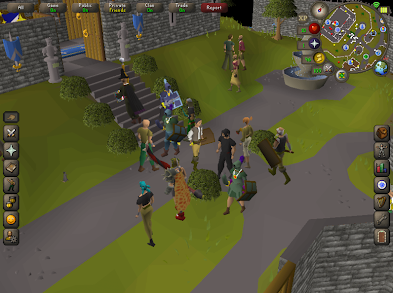10 minutes, 19 seconds
-29 Views 0 Comments 0 Likes 0 Reviews

High Repair and Supply Costs in Old School RuneScape: The Hidden Gold Sink Every Player Faces
In Old School RuneScape (OSRS), managing your gold efficiently is about OSRS gold more than just earning it—it’s about controlling how quickly it slips away. While skilling, trading, and monster drops provide steady income, repair and supply costs represent some of the biggest drains on a player’s wealth, especially for those who engage in high-level PvM (Player vs. Monster) content or long bossing sessions.
Let’s break down why these costs can be so high, how they impact your overall gold balance, and what strategies you can use to minimize them over time.
1. Understanding RuneScape’s Gold Sinks
Before diving into specific repair and supply costs, it’s important to understand the idea of gold sinks.
A gold sink is any mechanic that removes currency from the game to maintain economic balance. Without these systems, gold would accumulate endlessly, driving inflation and devaluing every coin you earn. Repairing gear, buying consumables, and paying service fees all serve this purpose—keeping the economy stable but also making it harder for individual players to hold onto their wealth.
In short, every repair bill or potion restock helps keep the market healthy—but it also chips away at your savings.
2. The True Cost of Repairs
Many of the most powerful pieces of equipment in OSRS degrade over time. Players who rely on high-end weapons and armor for PvM or PvP will eventually face steep repair fees that add up fast.
Common Repairable Gear
Item Repair Cost (approx.) Notes
Barrows Gear Varies (up to 330k for full set) Degrades during combat; repair at Bob’s Axes or an armor stand.
Crystal Armor & Weapons Up to 3–5 crystal shards per 10% charge Degrades over use; often used by high-level ranged players.
Crumbling Weapons (e.g., Dharok’s Greataxe) Similar cost to other Barrows items Powerful but costly in long PvM grinds.
These items are strong for their tier, but players often underestimate how much gold they burn through when constantly repairing gear. For example, a player using Dharok’s set for Slayer tasks might need multiple full repairs weekly—each eating into their profits.
Tip: If you’re doing long PvM sessions, repair items at your player-owned house armor stand after boosting your Smithing level with a potion. Higher Smithing significantly reduces repair costs.
3. Consumables and Supply Costs
Even if you avoid repairable gear, consumables like food, potions, and runes represent a major recurring expense. These items are essential for survival and damage output, but their cumulative cost can quickly outweigh your profits—especially in lower-tier combat or inefficient farming runs.
Most Common Gold Drains in Supplies
Food: Sharks, Anglerfish, and Manta Rays are standard for high-level PvM but cost thousands of coins each.
Potions: Prayer potions, Super restores, and Saradomin brews are vital for bossing and raids. Prices spike after major updates or events.
Runes: Magic users burn through tens of thousands of runes in extended slayer or raid sessions.
Ammunition: Ranging setups using Dragon arrows or Broad bolts can rack up hundreds of thousands in costs per session.
Example: A single 2-hour run at Theatre of Blood can cost a player 500k–1M GP in consumables, depending on their setup.
4. The Psychological Trap of “Profit Over Time”
Many players focus only on gross profit—how much gold they earn from drops or loot. But net profit (after expenses) is what truly matters.
For instance:
You might make 2 million GP from a Slayer session.
But if you spend 700k GP on food, prayer potions, and armor repair, your actual profit is only 1.3 million GP.
Ignoring this reality can make players overestimate their progress and fall into a constant cycle of spending just to maintain the same gold level.
5. Strategies to Reduce Repair and Supply Costs
a. Use Cost-Efficient Gear
You don’t always need top-tier gear to be effective. Many mid-tier items offer great value without repair costs.
Swap Bandos armor for Fighter torso or Torags during casual tasks.
Use Abyssal whip or Dragon scimitar instead of expensive degradable weapons.
For ranged combat, consider Rune crossbows or Magic shortbows to cut down ammunition costs.
b. Make Your Own Supplies
If you have high-level skills, you can offset costs by crafting or brewing your own materials:
Fishing + Cooking: Catch and cook your own high-tier food.
Herblore: Make your own potions instead of buying them.
Runecrafting: Create your own runes to save money in the long term.
c. Track Your Expenses
Keep a simple log of what you spend on supplies and repairs per hour or per run. Over time, you’ll spot patterns and find ways to reduce unnecessary spending.
d. Train Smithing and Construction
Smithing: As mentioned earlier, boosts to Smithing can significantly lower armor repair costs.
Construction: With a high-level player-owned house, you can create altars and teleport systems that save on prayer potions and teleport runes.
e. Buy in Bulk When Prices Are Low
The OSRS market fluctuates constantly. Buying consumables in bulk during off-peak times or after content updates can save millions in the long term.
6. When Spending More Is Actually Worth It
While minimizing costs is important, there are times when higher expenses yield higher profits. Efficient gear or potions that speed up kills or reduce deaths can make you more gold overall.
For example:
Using Saradomin brews and Super restores in the Inferno might cost millions, but the successful completion is worth far more in prestige and drops.
Equipping degradable high-end weapons like Scythe of Vitur or Twisted Bow drastically improves kill times in raids, leading to higher net profits despite repair costs.
The key is knowing when an expense is an investment versus a waste.
7. Balancing Income and Expenses
To maintain healthy finances in OSRS, follow the same logic real investors use:
Keep a steady income stream from consistent methods (like Slayer, Zulrah, or skilling).
Set aside a portion of your gold for repairs and consumables each week.
Avoid splurging on luxury gear until you can comfortably afford upkeep.
If your expenses frequently outweigh your income, consider diversifying your money-making methods or temporarily switching to low-cost activities like Thieving, Runecrafting, or Boss Pet Hunts that don’t require expensive setups.
8. Final Thoughts
High repair and supply costs are an unavoidable part of the Old School RuneScape experience—but that doesn’t mean they have to hold you back. With careful planning, crafting your own supplies, and making smart gear choices, you can dramatically reduce your spending without sacrificing efficiency or enjoyment.
Remember: the richest players in RuneScape aren’t always the ones who earn the most gold—they’re the ones who spend it wisely. Managing your repair fees, potion costs, and resource usage will not only save you millions over time but also make your entire gameplay loop more sustainable and rewarding.
And for players who want to skip some of the grind or recoup losses after expensive repair bills, there’s always the option to buy RuneScape gold safely from trusted sources—helping you get back to what really matters: mastering Gielinor’s toughest challenges with OSRS gold for sale confidence and control.



